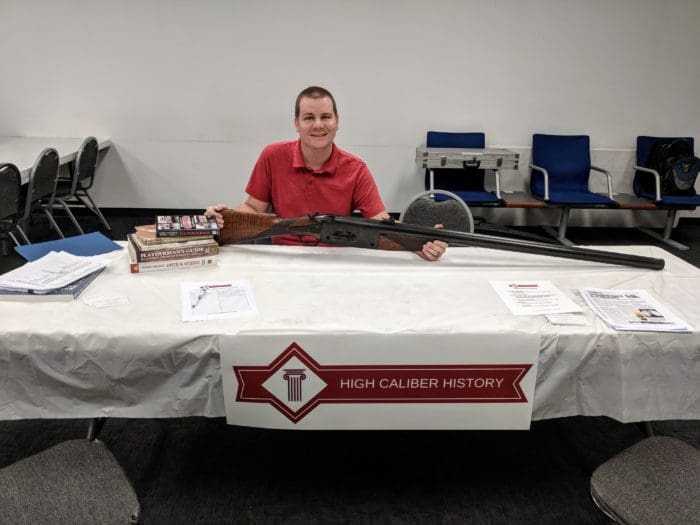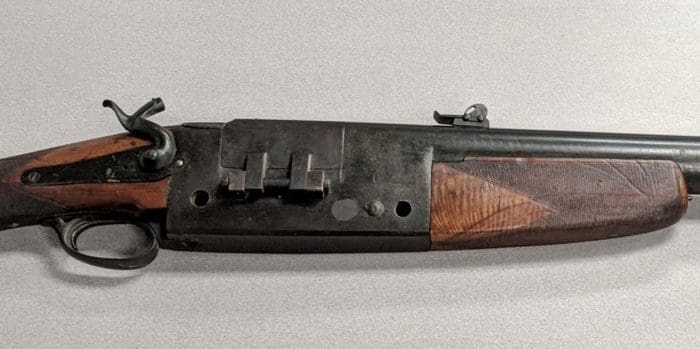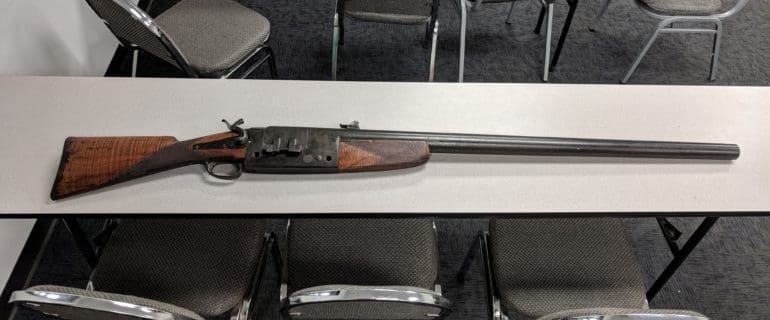I’ve always been a fan of “Antiques Roadshow” on PBS. From time to time, a firearm will pop up on the program, but they are few and far between. That’s why I jumped at the opportunity to take High Caliber History LLC on the road to Top Gun Shooting Sports in Taylor, MI, for an event I call “Gun-Tiques Roadshow.”
Among the guns to show up was this gigantic punt gun – at least that’s what I’m calling it – that weighed at least 50 pounds and took up almost the full length of an 8-foot table. Unfortunately, the owner knew nothing about the piece. He bought it 5 years ago just because he thought it was cool – and who could blame him!?!

To be fair, it isn’t exactly a true punt gun because it has a rifled barrel. I don’t know the actual caliber, but I can say with confidence that it is bigger than a 4 bore. Two holes in the receiver lead me to believe that it was probably designed to be bolted onto a swivel of some kind.
The action was also unusual: the breech block – which looks like someone just took a hunk of metal, added a hinge, and said, “Good enough!” – opens like a sideways trapdoor on steroids. The firing mechanism utilizes a back action shotgun lock with an external hammer that falls onto the external portion of the firing pin.
The entire gun is solidly constructed by someone who knew what they were doing when they made it, and yet, it also exudes overall qualities that would make “Bubba the Gunsmith” proud.

The only markings anywhere on the gun were two tiny ones stamped on the breech block that had gone unnoticed since it had been purchased. The first was a breech proof known as a Perron, and the second indicated what proofing inspector performed the action.
Based on this information, I was able to determine that the gun was made in Belgium sometime between 1952-68 or 1974-80 due to a break in employment by the inspector. As for who made it and why … well, that’s anyone’s guess. Most likely, the answer is, “just because.”
If you have any ideas as to the “who” or the “why,” please chime in. I’d love to know!
Logan Metesh is a firearms historian and consultant who runs High Caliber History LLC. Click here for a free 3-page download with tips about caring for your antique and collectible firearms.





Where’s Ian McCollum when you need him…
OMG guys, for a gun site you sure don’t know much. In fact this question is so easy I’ll leave it to some other luddite to share his/her wisdom. I’m tired to taking all the credit for knowing everything.
(of course sarc)
Actually it does look like a tripod mounted commercial hunting gun. Probably the reason we know have hunting seasons and licensing, and strict hunting rules and locations.
I thought commercial hunting was out before the 1950s? The 50s or 70s seems late for that.
The US is not the only country in the world.
Commercial hunting outside the US was practiced in some countries through the 80s, and in some is still going on, though regulated.
You beat to it. +1
Was probably for comercial water foul hunting. You could take a flock of pterodactyls down with it.
But a rifled barrel? To enhance the spread of the pattern? I guess when you’re slinging a pound of shot at a time you can afford to just say “fuck everything in this general direction.”
Beats Me! At first I thought it was an “Irish Tom”, but I can’t remember seeing one less than 14-feet long…
I was going to say ‘wall’ gun but it was made way to late for that.
This may have been a rifle used to clean the inside of a commercial kiln google kiln gun and more info will pop up
See. This is why I’m a fan of this site. Random trivia about firearms and their history. I learn new stuff all the time.
Kiln gun. Who knew?
Maybe an old version of this, then?
http://winchesterindustrial.com/equipment.html
Man. I want both of those. That bottom one looks like a modified 1919 Browning and that top one looks like a cross between a water cooled BMG and a small naval gun.
Likely illegal to look at those pictures here in CA.
“Man. I want both of those.”
Wouldn’t you rather have one of these? –
“On Mammoth Mountain, avalanche control requires bringing out a big gun — the 105-millimeter Howitzer”
http://www.latimes.com/local/lanow/la-me-ln-mammoth-howitzer-20170108-story.html
Why not have them all. To quote my favorite range-worker “This is ‘Murica!” *flex beefy flag-tattooed bicep*
Only commercially loaded ammo for my old 8ga. IIRC, from Remington Commercial for the express purpose of the kiln gun.
I think they still sell the guns and the ammo. Good for removing reticent slag from what I’ve heard.
“I think they still sell the guns and the ammo.”
Remington apparently still does so.
And a number of the loads are zinc and lead slugs up to about 3 oz, so that jibes with the rifled barrel.
I’m not surprised, the nail gun loads I’ve seen on construction sites had a Remington head stamp on what looks like a crimped .22 rimfire. Different colors for different loads…
“Good for removing reticent slag…”
in case trump hadn’t won…
Kiln gun makes sense in an odd kind of way. That said the actual 8ga ones certainly fall into “obscure object of desire” for me.
Built shortly after the Farmington Armada incident, this gun was shipped to the States for testing against captured hostile beings……just joking of course.
It’s Friday and I’m ready to be off work.
Cool gun though!
Manse jolly….. testing to resume on Texas border.
The real question is “can I 3D print one?”
yup, but only in 6.5
http://www.wideopenspaces.com/forgotten-weapons-checks-out-one-impressive-belgian-75-caliber-percussion-wall-gun/
looks pretty close
A harpoon or line throwing gun might be a possibility. Whale hunting was common until the immediate post ww2 era. The gun could have been mounted in the bow of a boat – not one of the big commercial whale catchers which used guns that looked more like light artillery pieces – but maybe a smaller boat that would have been used by native peoples in Alaska or Greenland.
Line throwing guns were used to propel a weighted rope (line) from ship to ship or shore to ship. I saw line guns used as recently as the early 70s although they were modified single barrel 12 gauge shotguns. They shot a heavy slug that had a light rope attached. The light rope was then used to pull a heavier line and then oil hoses and wire ropes for the transfer of “gas, beans and bullets” from a supply ship to our cruiser.
There’s also a possibility that the gun might be much older – the style and workmanship seems to have a late 19th to early 20th century “look” and the proof marks might have been added at a later date. The rifled bore’s got me puzzled. I don’t think its a fowling piece because as others have noted rifling would mess up the shot pattern. The fact that gun has adjustable sights would make you think that some fairly long range work – at least to a couple of hundred yards – was intended.
It is a very cool piece and would look good hanging over a fireplace. I’m not sure that I’d have the testicular fortitude to shoot it but it certainly has possibilities as a “get off my lawn” gun.
Line guns aren’t rifled. A buddy of mine has one. It’s pretty cool. He has the whole “kit”.
Line-throwing guns are still used today, although as Tom pointed out, they’re smoothbore, not rifled, so this isn’t a line-throwing gun.
The U.S. Coast Guard and Navy use a .45-70 blank cartridge called the M32 for line-throwing guns.
If you search Wikipedia for .45-70, you will see this: “The .45-70 cartridge is still used by the U.S. military today, in the form of the “cartridge, caliber .45, line throwing, M32″, a blank cartridge which is used in a number of models of line throwing guns used by the Navy and Coast Guard. Early models of these line throwing guns were made from modified Trapdoor and Sharps rifles, while later models are built on break-open single-shot rifle actions.”
You can buy Coast Guard approved line-throwing “guns” (line launchers) here: https://www.navalcompany.com/linegunkit.htm
That makes sense – I was a snipe (Engine room guy) so I didn’t know what the deck apes were doing or shooting. Ask me about steam turbines, pumps and air conditioning and we can have a great discussion. Anyway I saw a beak open action and assumed that it was a shotgun. I’ll agree that the guns weren’t rifled but they worked. Thanks for the education.
Deck gun was the first thing I thought of as well, but the rifling? I imagine we’ll get a forgotten weapons episode about something like this eventually
Former Gunner’s Mate here. The old .45-70 break action line throwing guns the Navy used to use have mostly been phased out in favor of an M-14 using blanks and a line throwing kit.
It’s a make shift mounted gun for commercial duck hunting.
When you have these “what’s this old gun?” questions, you guys really, really need to take some high-resolution photos, closeups of proof marks, serial numbers, etc.
Showing gun experts these small, low-res pictures and asking “what is it?” is about as frustrating as gun owners who call me on the phone, describe their problem and ask “what do you think is wrong?”
“I dunno. Put your gun on the phone and let me talk to it.”
There’s lots of things about guns where you must be able to see details. Small details. There’s a reason why there’s four different optical magnifying systems in my shop – and probably every other gunsmith’s shop. Details matter.
As stated in the article, there were only two markings on the gun, both of which I already identified.
But you didn’t take any pictures of them… or any of the other details on the gun.
Bigfoot.
NOTE: OP says proof was either “1952-68 or 1974-80”
That makes no sense to me (unless a prototype of an RP/digital printing exercise)
Those dates come from the dates of employment at the Belgian proof house by the inspector who proofed the gun. He worked there for awhile, left, and then came back.
SOooo..WTF Is It?? besides a BFG.
Big Friendly Giant? That’s a movie, right?
Someone didn’t have a misspent childhood…
https://en.wikipedia.org/wiki/BFG_(weapon)
That hammer and lock plate look like something from the mid 1800’s, like a percussion muzzle-loader. And the hinged door like thingy reminds me of a cartridge conversion rifle, like a trapdoor rifle or some such. Are you sure the rifle was made as late as the 1950’s? Looks like something that could have been made in the mid to late 19th century, then proofed later on when someone wanted to know if it was safe to shoot….?
Kinda looks like an EJ Churchill Rewa rifle. But “custom” made with that Snider-esque hinged breech.
My best guess is a one-off elephant gun. .577 or .600 NE?
Still waiting for the final episode of Antiques Roadshow in which one of the appraisers is presented a Lament Configuration by a clueless walk-on, attempts to evaluate it, and unleashes bloody cenobite carnage in the studio.
It is a 3D printed AK-47.
-Writer, The Washington Post
i think people are overlooking the obvious,
i’m going to call it an african stopping rifle,
it’s just as likely that whomever built it ordered the barrel from belgium, and then had a local smith fabricate the rest
@ jwm.
Ring Blasters like that of the Lower Picture are “Not” particularly cheap! Low-Ball Price starts at ~$4,500.00 USD. and is classified as a 8-gauge Shotgun. Has a Short Ranged at about 25-meters, but has the Stopping Power equivalent to that of a .700 Nitro Express…
Yeah. But think how popular you would be around New Years and the 4th of July.
Looks like the only commie kalifornia approved rifle the serfs are allowed to……..
Law Enforcement is exempt of course.
I’d say the theory advanced previously of the barrel being ordered from a Belgian maker and being assembled locally (wherever that might have been) is accurate. I’d guess it was assembled in Africa (Belgium Congo/Ruanda) to get around restrictions on more modern designs and/or because it was cheaper to do so.
Probably made it’s way here prior to 1968 (Probably in the late 1950s) when some well-heeled safari goer brought it back as a souvenir. A chamber cast identifying the cartridge may prove useful.
Line throwing gun came to mind, until I saw references to “kiln gun” in the above, which strikes me as closer to the mark. It was years ago, that I happened on an article that spoke to/of kiln guns.
Comments are closed.